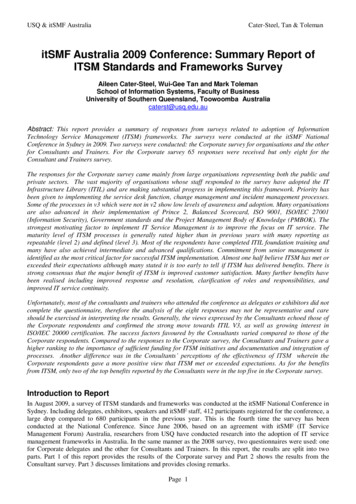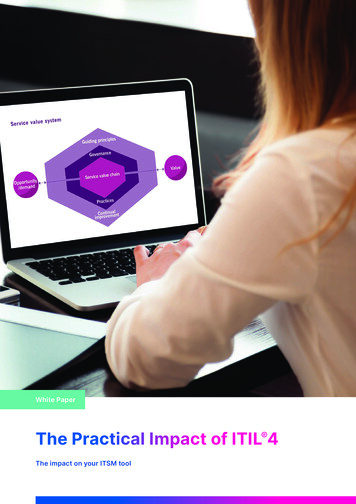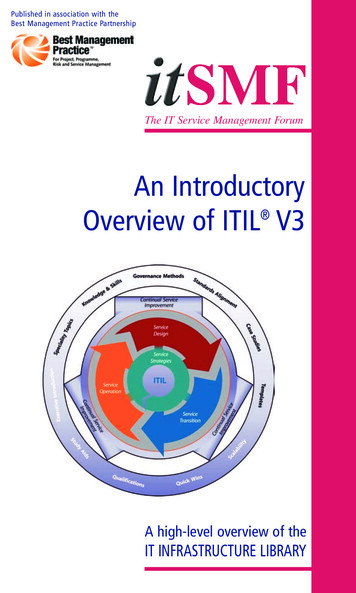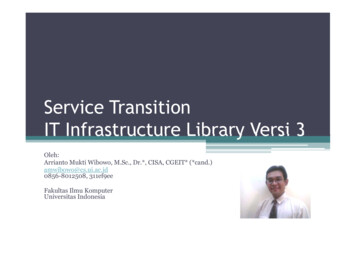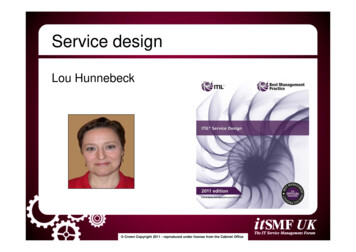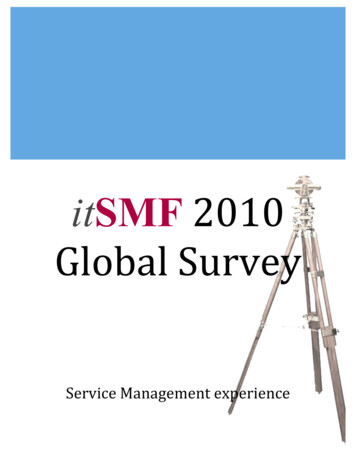
Transcription
itSMF2010GlobalSurveyServiceManagementexperience
pyrightnoticeThis survey is copyright to the itSMF - www.itsmf.com - for permission touse this for any reason, contact marketing@itsmfi.org.Permission is granted, for personal use only, to paid up members of theitSMF worldwide.Permission is granted, to paid-up chapters of the itSMF, to use thismaterial for chapter marketing purposes, so long as the copyrightconditions are specified in such material. copyright 2010 itSMFPage2of23
ntsonprojects1911.Recommendationsfor2011survey22 copyright 2010 itSMFPage3of23
itSMF2010GlobalSurveyServiceManagementExperience1. espondentsarenotchosenatrandom,theyareself- dISACAweb- BusinessDevelopment copyright 2010 itSMFPage4of23
Whorespondedtothesurvey1.1. CountriesFigure1WhoResponded copyright 2010 itSMFPage5of23
1.2. perienceFigure2IndustriesRepresentedinSurvey copyright 2010 itSMFPage6of23
erienceservice managermanagerdirectorconsultantauditorservice delivery managerproject managerprocess managerchange manageranalystcsi manageroperations managerquality managersecurityservice desk managerconfiguration managerincident managerrisk managerproblem managerservice level managervice presidentceocomplianceadvisorcioitsm consultantprogram managersecurity managerservice support managerdevelopment managergeneral managerhead of 77666managing directorsecurity consultantsystems analystsystems managerarchitectgovernanceproduct managerrelease managersupport managerglobalprocess consultantrelationship managerstrategysystem administratorapplication managercisoctodatabase administratordelivery managerdeveloperfinance managerhelp desk managerpartnerproject leaderrisk consultantsalesapplications managerassurance manageraudit manageravailability managercompliance csidsieducation managergovernance managerinfrastructure managerinternal auditoritil service manageritsm managerlecturermanaging consultantnetwork manageroperations directorpractice headpresidentprocess analystprocess architectprocess engineerproduction managerquality assurancerisksales directorsecurity architectsecurity specialistsolution architectsolution managerspecialistteam managertechnical consultanttraining managertransition managerRoles shared by two or more contributors shown. There were 179 job descriptions that wereunique. Of these, the most common keywords were:manager (59), service (25), consultant (15), specialist (10), itil (10), engineer (9), systems (8),support (8), security (8), network (8), system (6), process (6), operations (6), analyst (6) copyright 2010 itSMFPage7of23222222222222222222222222222222
core 10080-100%20-80%0-20% 0%% ofrespondents7.30%43.90%42.50%5.10%1.10%# ofrespondents804794645612Project ResultExtremely successful - Better than expectedVery successful – but within expected rangeSuccessfulMarginal resultUnsuccessful – a failed ivenforthoseprojectsthatfailedwere: As a result of poor implementation., Project was cut just before rollout due to contract issues with 3rd party, Although theitSMF project never came to fruition, the process allowed us to see the gaps anddeficiencies in our current processes that must be rectified before the processes flowcorrectly.Results are negatively influenced by one major IT project really going wrong., wingcomments: Won2008ITSMFProjectoftheyearaward Wehadhighexpectationsandmetthem ers. sprocessautomationforthesupplychainofIT utomationusingtheindustryleadingBPMS. n1yearofhire. copyright 2010 itSMFPage8of23
singServiceManagementThe first four reasons cover over half the respondents it can be seen that these mainly involveIT, rather than Business or Strategic goals.It is significant that 13.08% of Service Management users do, though, exist because of BusinessRequirements.The economic downturn is evident from the emphasis on cost and risk reduction. copyright 2010 itSMFPage9of23
ficationsforpreviousServiceManagementProject4.1. Otherjustificationsused Access to specialist skills not available internallyBased on the rollout of Problem ManagementCompletive advantageContractual requirementCreate service values to customersCulture and staff moralDeveloping SD function and boosting incident and problem management processesISO/IEC 20000 certificationKPI and SLA Alignment with our Outsourcing partnersMarketingNeed for global consistency/standards to integrate multiple companies/infrastructureOur business is currently changing so much that we need to create a new servicestrategyProcess flow - All processes. Adding Request and Knowledge processes copyright 2010 itSMFPage10of23
itSMF2010GlobalSurveyServiceManagementExperience Process reviewProject for clientsService Management program within the company is a Group initiative to supportbusiness model betterStrategic Alignment, ITIL as a means to become partner of our customersTo ensure great audit results (and we got the highest score)Value Case (as opposed to Business Case)Want to go to Best-Practice methodologies and (seenextsection)isverymuchwork- ‐in- flectionofthegeneralbusinessclimate. copyright 2010 itSMFPage11of23
’graphs. copyright 2010 itSMFPage12of23
fskillsOtherskillsmentioned: ASL and BiSL Business Continuity CISA I-Cubed Internal Governance / Requirement Management ISO 14001, OHS 18001, ISO 31000, CMMi, ISO 19011, ISO 9001: 2005/8 ISO9001 certification ITIL Practitioners KCS LEAN (Six mentions) NIST, FISMA, FISCAM, Expert - 5, IT Subject Matter Expert - 5 PMP priSM Credential Project Management(e.g. PRINCE): Company has own best practice methodology project managementReal world experienceRISK ITSoft skills (Communication etc. 4), Organizational Change Management (4), TrainerCapabilities (4) copyright 2010 itSMFPage13of23
Otheractivitiesmentioned: Transition Planning and Support: Company has own best practice methodology for transition and transformation projectsTrainingService Improvement (CSI)Really good at this for Customers' managed services; not so good at applying these itemsto our own internal practices (i.e. what do WE define as an INCIDENT to providingservice . for example Remedy7 going down)Order management (in progress), Skill management (in place) Continual ServiceImprovement (for processes in place), Organizational Training (in place),Software/System Development Process (in place)Dashboard and BIContinuous process improvement copyright 2010 itSMFPage14of23
rtoolsmentioned: BPMS e-engine products IT Architecture, Design, Build, Test, Release, IT Solution Delivery management. Knowledge Management Process design-Tools (ADONIS), Deployment Tools Request Service Desk Vendor Management copyright 2010 itSMFPage15of23
ServiceManagementprojecteffectiveness9.1. effectively. copyright 2010 itSMFPage16of23
2. tdeliverasintended. copyright 2010 itSMFPage17of23
mmentsontherecentServiceManagementproject: Improved Awareness Didn't do what the Sales people claimed was its 'bread and butter' Improved management of workflow and workload with business processautomation for the supply chain of IT Increased knowledge of ITSM Abandoned copyright 2010 itSMFPage18of23
. ontheground. A project has started but never finalised. A reorganisation didn't really help the problemsare in siloing the processes and lack of accountability and championship from highermanagementAlthough the itSMF project never came to fruition, the process allowed us to see the gapsand deficiencies in our current processes that must be rectified before the processes flowcorrectly.Driving Service Management projects in one division of a very large multinational isachievable, but the biggest issue you face is the integration to other parts of theorganization such as external vendors, outsourcing partners, other applicationdevelopment groups, or suppliers of service. ITIL is much easier to "sell" in real terms ina 70K company than it is in a 350K employee company.I am contracting to a Bank and the Executive management have a culture of customizingeverything. The problem is they customise the wrong thing. ITIL is a Buzzword and if youask the exec why they are aligning to ITIL they will give you a blank stare or a fluffyanswer. ITIL is frameworks not play dough/putty, a concept that is lost in theorganization.Instead of the classical approach we went with an Alignability Process Model, deliveredto. This has had a huge positive impact on our ITSM initiatives and I can recommend thisto all fellow members.IT Service Management's Service Operation, Service Transition is very well matured inmany parts of the world. It is time for itSMF to aggressively work with Corporates to getthem to embark on next milestones.There are not enough tools that can reallycalculate some of the questions asked in #14. Vendors also play a vital role in this. Andlastly, I believe in coming months/years itSMF will play an important role to bring allthese processes to reality.ITIL V3 politics, role of Exin/APMG destroyed the Dutch market. People are still waitingfor a workable solution. ITIL is not longer leading and due to the politics, business is lost.I prefer a situation that the client is leading in the decision for tooling and/or metrics.Now APMG is (by stopping ITIL v2).ITSM seems to be an issue that should be covered as a whole, setting targets forindividual areas independently but thinking of big picture the whole time. ServiceLifecycle model of ITILv3 is really nicely built and adds value to our functions. I hopeitSMF International would push forwards common education of ITSM in universities(tech/biz) to make our profession a real profession, not just a practice.ITSM is something the company is doing globally, but initiatives from the local offices arein play. For me, responsible for Australia and New Zealand Technical Services for thecompany, many of these service management areas of ITIL are extremely important.My organisation outsources a significant portion of its IT operations and IT ServiceManagement processes to a global IT service provider. I think a question to identify thisshould have been added. The performance of my organisation's IT service managementis underpinned by the performance of this global IT service provider.One of our capacity development projects was to roll out IT training to all IT practitioners(staff in IT departments). We have trained approx 60 % at foundation level, 20 % atpractitioners level and 6% at manager’s level using donor funds. This has irrevocablychanged the IT landscape at all the universities. Change and release management insome form is now present and all institutions have incident and problem management copyright 2010 itSMFPage19of23
itSMF2010GlobalSurveyServiceManagementExperience and a service desk in action. For our own organisation is has allowed us to transitionfrom a bandwidth agency to one in which we now supply IT services ourselves. We arehave now transformed to a fully-fledged NREN. The only member of staff who does nothold any ITIL qualification is the CEO, but we have "deemed" him to be at theFoundation level and so have excused him from attendance on a course. Our company isan NGO not for Profit Company.Overall it was good to have Best practices of ITIL. The Service Delivery has now becomepredictable and has improved the efficiency of overall IT. Achieving benchmarking bycomplying with ISO 20000 has given tangible benefits. The KPIs for different processhelps monitor the health of the IT Services.Service Management got from initiation stage where we trained more than 50 staff inITIL foundation. After a year, we are still at a planning stage. Not at execution orimplementation yet. It’s hard to get the commitment from the senior management levelto see its relevance to IT, where time and effort need to be spent. There need to be anactive focus group and meeting the primary needs first not wants. If ServiceManagement projects want to take off it should be managed as small and multipleprojects and in stages. There are too many distractions and CIO need to be the ownerand support this fully.There are too many blocks - especially the culture and statinghe objective and ROI clearly to get buy in.Service Management projects are not as successful as they should be due to the skill setof the manager responsible for the area. The SME's are not listened to or respected by1980's attitude of SM manager thinking he is the only one that can think strategicallyabout SM conceptsSome issues I see are getting all departments on the same page and realizing we workfor the same company. Poor managing of client expectations and I suspect poorinteraction between client and our Service Managers and CRMs. SM outcomes and clientinteractions varies wildly depending on the SM involved. Poor implementation of tools tosupport IT processes. We seem to make the same mistakes over and over again. e.g.instead of purchasing a tools and using it off the shelf, we modify to the hilt and disableuseful features, before going live. With the natural outcome of a hostile reception to theprocess, because the tools doesn't support the process. Where the tools support theprocess, one normally has a happy triad of People, Process and technology.The adoption of a new Service Management toolset for aspects of the organisation'sITSM efforts has been well received, but sadly other aspects of business governancehave not kept pace. There has been a marked lack of emphasis on certification(ISO27001, ISO20000 etc), the results of which would go far to reassure observers thatcorporate governance is taken seriously. If governance and certification fail to go hand inhand, an opportunity will have been missed to deliver management results that aretransparent to outside stakeholders and provide assurance, within and without, that all iswell. Such an oversight has the potential to harm the organisation's reputation - andviability - in the long run.The company has many Service Management solutions even though they are aligned toITIL v2 & v3 they are still areas we need to concentrate in the integration side, cloud andneutralization.The current project is showing improvements by means of enabling standard practices,efficient master data management for decision making, agile reporting. The businessvalue from the project are expected to be realised by end of Q4 2010 or Q1 2011The organisation has under invested & too many short term goals aimed forThere are many specialised teams across three ICT groups (the organisation has clusters(deputy secretary), groups (group managers, branches (branch managers, sections(senior directors and directors), teams (assistant directors)) so a lot of the questions copyright 2010 itSMFPage20of23
itSMF2010GlobalSurveyServiceManagementExperience have different answers depending on what part of the broader ICT organisation youanalyse.There is no instrument to identify that an ITSM project is the reason for cost reduction inservice delivery, since at the same time there are several other initiatives that also leadto higher or lower costs. There is a lack of benchmarks for processes. Today we can onlybenchmark products.To be successful with Service management maturity the organisation needs to setup anindependent process maturity team that is respected by the executors of the processesto review and track process maturity team and report to CIO and leadership team.We have had cultural problems.We have very well defined processes in place. We have organization wide ISO27001 &CPMM level 5. We follow Six Sigma methodology based upon client's requirement. Webelieve in 'Customer Delight' and put our best efforts to achieve that.We lead with ITIL v3, and need to incorporate more regulatory ISO and ISACA practices(Cobiit, for one)Whilst we would like to believe that service management and customer satisfaction aredirectly correlation, the connection to business value is a soft one. The awareness ofshortcomings became more widely known. A problem shared is not necessarily a problemhalved. The return will be longer term as the ad hoc behaviours mature. It will be hard toassociate improved performance on the balance sheet. Financial measures reign.With no real understanding from senior management, projects are doomed to fail. copyright 2010 itSMFPage21of23
. entiallysound.Thedesignobjectiveswere: It should be as easy to understand as possible for those whose firstlanguage is not English It should be as short as possible It should be as easy to fill in as possible It should provide as much useful information about Service Managementin its current state as possible It should be general enough to be repeatable annually without muchmodification To take as little time to fill in as heresultsarefairlytime- gtoin- ‐sourcingorout- ‐sourcingmightbevaluableaswell. copyright 2010 itSMFPage22of23
itSMF2010! Global!Survey! ServiceManagement!Experience! copyright 2010 itSMF Page7of!23! 1.3. Roles, service manager 73 managing director 6 csi 2 manager 66 security consultant 6 dsi 2
